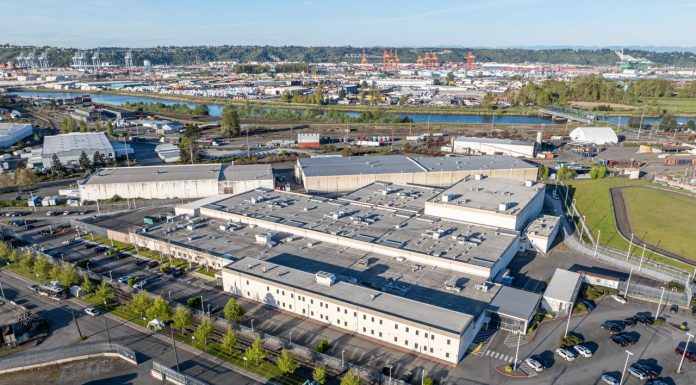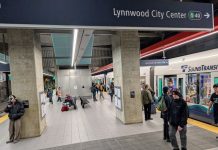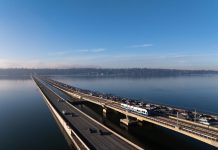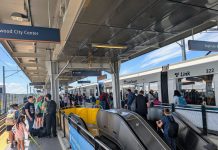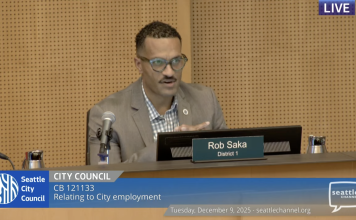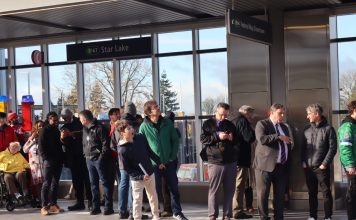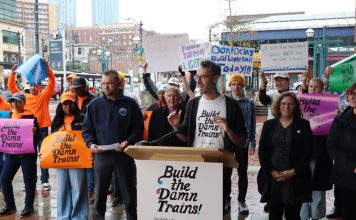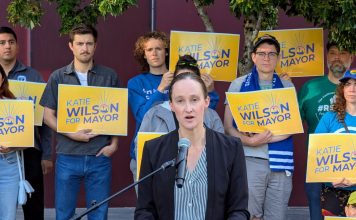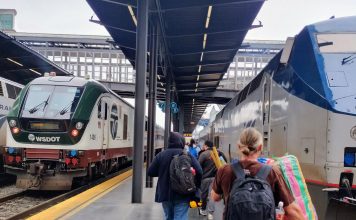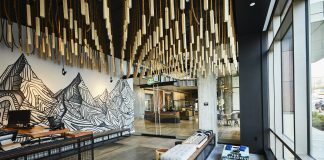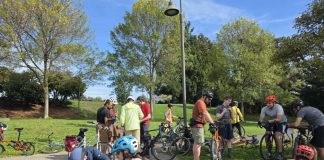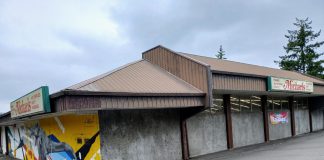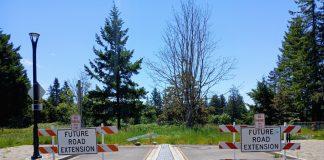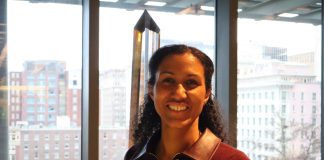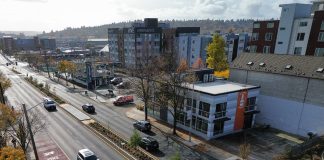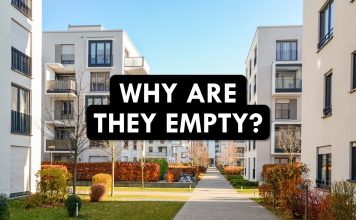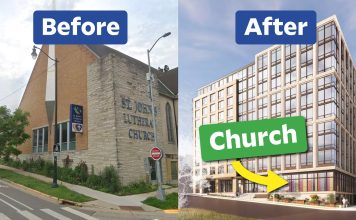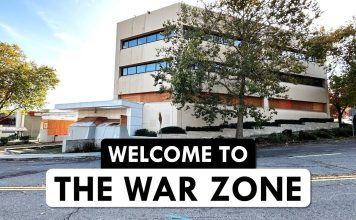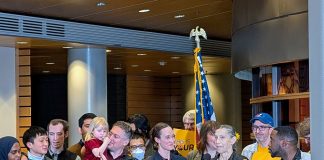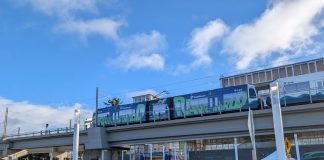More recent posts »
Washington state leaders should take action to force the closure of the Immigration and Customs Enforcement penal colony in Tacoma, which is carrying out the unlawful detention of 1500 people.
Recent Posts
Seattle Braces for Downtown Light Rail Closure and I-5 Bridge Work
1 Line light rail service will be disrupted starting 10pm Friday through Sunday, January 11, as Sound Transit conducts signal work in preparation for the 2 Line extension. Stations from Capitol Hill to SoDo will be closed with replacement bus service offered. WSDOT is also launching Revive I-5 work on the Ship Canal Bridge this weekend.
Crosslake Light Rail Approaches One of Its Final Milestones
With simulated light rail service across I-90 less than a month away, Sound Transit appears poised to beat its deadline of opening the full 2 Line by May 31. Simulated service will also bring increased train frequency between International District and Lynnwood, a big boost for riders.
Urbanist Podcast: New Year, New Mayor, New Budget
Ryan Packer, Amy Sundberg, and Doug Trumm kick off the new year by breaking down Seattle Mayor Katie Wilson's inauguration and Washington Governor Bob Ferguson's budget proposal, which included deep cuts to public education, while also queuing up a millionaires income tax for 2029.
Dionne Foster Takes Office, Aiming to Tackle Housing Issues
Seattle City Councilmember Dionne Foster took office Tuesday, echoing Mayor Katie Wilson's call for "bread and roses" to tackle the city's affordability crisis while strengthening the social and cultural fabric.
Op-Ed: Katie Wilson Can Be Seattle’s Climate Mayor for Renters
Seattle renters are largely locked out of cost-saving and comfort-improving clean energy appliances, like heat pumps, induction stoves, and solar panels. Sightline's Emily Moore argues that newly inaugurated Mayor Katie Wilson could help change that, in part because Seattle owns its own electric utility.
Erika Evans Takes City Attorney Oath, SPOG Goes on Attack
On Monday, Erika Evans was sworn in as the first Black Seattle City Attorney, following a resounding victory over Republican incumbent Ann Davison. The Seattle police guild was already on the attack, seeking to brand her soft on crime.
Op-Ed: Sea-Tac Airport Transportation: Off the Road and Onto the Train
With 46,000 workers commuting to the Seattle-Tacoma Airport every day, Commissioner Toshiko Hasegawa shares the Port of Seattle's plans to improve transportation options and encourage transit use.
Join us for The Urbanist January Socials and North Sound Election...
Join us for our January socials in Seattle and in Redmond, plus a special North Sound event recapping the 2025 election and looking to the political battles ahead.
Two Weeks Until The Urbanist’s Winter Holiday Party
Get your ticket to The Urbanist's annual holiday party while supplies last. Our speaking program on December 9 will feature Seattle Councilmember Alexis Mercedes Rinck and other urbanist leaders and newly elected officials.
Join Us for The Urbanist’s November and December Events
Join for The Urbanist for our upcoming social meetups, Comprehensive Plan organizing, and our big holiday party extravaganza.
More events posts »
Support Our Work
The Urbanist is a 501(c)(4) nonprofit. We depend on donations from readers like you to sustain our work. Subscribe as a monthly donor or make a one-time donation to help us grow.
Kirkland Council Makes Way for Redevelopment of Contentious Juanita Sites
Up to 800 homes could advance on two underdeveloped retail sites in Kirkland's Juanita neighborhood thanks to a zoning update that raises height limits to 75 feet. The road to get to this point involved nearly two years of process, and nearly became derailed ahead of a final council vote.
Mayor Scrambles to Protect ‘Character’ of Old Bellevue with Emergency Controls
Bellevue Mayor Lynne Robinson's request would bring an emergency action to require facade preservation along Main Street as a condition of future development, while the city considers permanent regulations. While there was majority support for retaining the character of the area, some councilmembers cast doubt on the urgency and emergency framing.
Sammamish Hits Pause on Town Center Planning after Backlash Election
Following an intense debate over the future of Sammamish's fledgling Town Center area in this month's elections, three growth skeptics are set to join the city council. Now the question is just how dramatically things get scaled back in 2026.
More Eastside Coverage posts »
Dionne Foster Takes Office, Aiming to Tackle Housing Issues
Seattle City Councilmember Dionne Foster took office Tuesday, echoing Mayor Katie Wilson's call for "bread and roses" to tackle the city's affordability crisis while strengthening the social and cultural fabric.
Seattle OKs New Growth Plan, but Biggest Zoning Battles Lie Ahead
The adoption of the Seattle Comprehensive Plan, nearly one year late under a state-imposed deadline, is setting up much bigger debate over where additional housing density will be allowed in the city. Those issues, set to be discussed in 2026, include adding neighborhood centers and upzones along transit corridors.
Op-Ed: Making Seattle Neighborhoods More Accessible by Design
Four case studies show how Seattle's new middle housing zoning incentives align with demographic shifts to meet housing demand.
More One Seattle Plan posts »
Urbanist Podcast: New Year, New Mayor, New Budget
Ryan Packer, Amy Sundberg, and Doug Trumm kick off the new year by breaking down Seattle Mayor Katie Wilson's inauguration and Washington Governor Bob Ferguson's budget proposal, which included deep cuts to public education, while also queuing up a millionaires income tax for 2029.
Urbanist Podcast: A Light Rail Opening and Police Accountability Door Closing
Ryan Packer, Amy Sundberg, and Doug Trumm discuss the Federal Way Link light rail opening in early December, Katie Wilson's transition team and early hires, and the Seattle City Council's vote to approve a controversial labor contract with the Seattle Police Officers Guild.
Urbanist Podcast Election Extravaganza: Puget Sound Progressives Prevail
The Urbanist Podcast is back after a hiatus, just in time to break down 2025 election results. In this episode, Urbanist publisher Doug Trumm and reporter Amy Sundberg discuss what happened in Seattle, with progressive mayoral challenger Katie Wilson's dramatic victory, and other interesting races across the region.
More podcast episodes »

